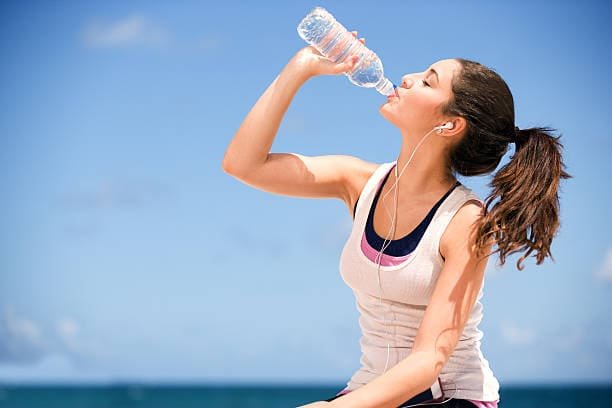
2025 is going to be a record hot year for the UK, and smart hydration for women in heat is becoming a real priority. Spring was the hottest on record and June was the warmest month ever for England. These sweltering summer months are bringing a whole new challenge to active women. If you’ve been noticing more fatigue, gastrointestinal issues, or a sense that your usual hydration and fuelling strategies aren’t working, you’re not alone. As these heatwaves become more frequent across the globe, many female athletes are suffering significantly more than their male counterparts. This is due to major physiological differences in how male and female bodies manage heat.
The Thermoregulation Gender Divide
When it comes to thermoregulation, there is a distinct difference in the way men and women respond. As the intensity of exercise increases, both sexes see a rise in heart rate, enhancing oxygen delivery to vital organs and working muscles. However, in the heat, the body prioritises these demands by diverting blood flow away from less critical areas like the gut and liver, by as much as 80%. This shift can lead to challenges in digestion and nutrient absorption, particularly once temperatures climb beyond 24°C.
What complicates matters is the nuanced way men and women dissipate heat. Women typically begin widening the blood vessels (vasodilation) earlier in response to heat, then maintain this state for a longer duration when compared to men with the same fitness level. Both sexes begin to sweat as their body heats up. However, women’s overall sweat output is lower. Research shows that even when matched for aerobic capacity or training status, men have a higher sweat rate and greater output per sweat gland, making it easier for them to cool. As exercise intensity and heat exposure increase, this gender gap in sweating becomes even more pronounced.
Adding to this complexity, just a small degree of dehydration is enough to significantly raise a woman’s core body temperature, which exacerbates heat‑related stress. Hormonal changes, particularly during the luteal phase of the menstrual cycle or during peri‑ and post‑menopause, can further complicate thermoregulation by affecting core temperature, sweat patterns, and fluid retention—leading to a heightened risk of dehydration and gastrointestinal distress.
Hydration
Proper hydration is critical for all athletes, but it takes on added urgency for women. Developing a tailored hydration strategy for exercise or competition is vital. Reasons for the differences:
- Lower Sweat Rates. On average, women have lower sweat rates compared to men, particularly during physical activity. This can diminish evaporative heat loss, potentially affecting the ability to cool down effectively in hot climates.
- Body Water Differences. Women typically start with a lower total body water percentage and possess lower sweat gland output than men. Consequently, a similar percentage of body mass loss can equate to a larger total body water loss for women.
- Increased Heat Sensitivity. Research indicates that women tend to heat up more quickly during exercise, intensifying the importance of effective cooling strategies and hydration management.
Exercise‑Associated Hyponatraemia (EAH)
When we sweat, we’re not just losing water; we’re also shedding sodium, a vital electrolyte. Unfortunately, relying exclusively on water without adequate sodium can dilute blood sodium levels, leading to a condition known as exercise‑associated hyponatraemia (EAH), often referred to as “water intoxication”. Interestingly, studies show that during similar endurance events, men generally finish with elevated blood sodium levels, whereas women typically complete these activities with normal or slightly reduced levels. This discrepancy can be attributed to the influence of sex hormones on fluid management within the body. Specifically, progesterone competes with aldosterone, the hormone responsible for sodium retention. This is particularly impactful during the high‑hormone (luteal) phase of the menstrual cycle or when taking oral contraceptives. This dynamic can lead to increased water retention and subsequently lower sodium levels.
Why are women more susceptible to EAH?
- Body Composition: Women generally possess smaller body sizes, resulting in lower fluid requirements yet a heightened chance of overconsumption.
- Endurance Event Duration: Prolonged race times can lead to excessive fluid intake.
- Hormonal Fluctuations: During the luteal phase, which is just before menstruation, hormonal shifts can result in increased sodium loss and altered fluid distribution, making it easier to dilute blood sodium levels.
- Water Retention Patterns: Research indicates that even with reduced fluid intake, women tend to retain more water and maintain lower sodium levels compared to men.
Optimal Hydration for Active Women
When it comes to staying hydrated, the sodium found in your sports drink serves a crucial purpose as it aids in fluid absorption rather than simply acting as an electrolyte replacement. Many women mistakenly believe that loading up on salt tablets or electrolyte additives is the key to hydration, but this approach can introduce a host of complications. Instead, consider your hydration method as just that—hydration. It shouldn’t double as a source of carbs or electrolyte replenishment. Tailor your nutritional choices to the specific demands of your event and environmental conditions, keeping in mind that you have limited capacity to carry hydrating liquids.
For optimal hydration, particularly in temperatures exceeding 25°C, aim to consume about 10 ml for every kilo of body weight per hour. So for a woman weighing 60 kg, 600 ml of water is needed per hour. However, there is no one‑size‑fits‑all beverage that will meet every activity’s environmental or race condition.
How to Enhance Fluid Absorption
Glucose and sucrose are sugars that facilitate fluid uptake when mixed in a concentration of 2–4%. This balance optimises the fluid’s transport from the intestines into the bloodstream while keeping its osmolality lower than that of blood (known as “hypotonic”).
Including sodium in your drink can help mitigate sodium loss in the intestines and support better fluid transport.
The Impact of Your Hydration Choices
What you choose to hydrate with during exercise significantly influences your body’s ability to absorb fluids, your digestive comfort, and ultimately, your athletic performance. Here’s a brief overview of what to keep in mind:
- Plain Water Isn’t Enough. While hydrating with plain water is beneficial, it absorbs slowly and can inadvertently draw sodium and water into your gut, impairing both hydration levels and energy.
- Avoid Hypertonic Drinks. Highly concentrated drinks—such as those with excessive sugars or high‑fructose content—can slow down absorption, causing bloating, cramps, or diarrhoea.
- Find the Sweet Spot. The ideal hydration solution contains a balanced mix of sodium and glucose at a lower osmolality. This combination ensures rapid fluid absorption, which is essential for maintaining blood volume and enhancing performance.
- Be Cautious with Maltodextrin. Though maltodextrin, commonly found in sports drinks, seems appealing because it doesn’t heavily impact osmolality, it can still slow fluid absorption, especially in women with sensitive gastrointestinal systems.
Mastering the Art of Staying Hydrated for Optimal Performance
Consider supplementing with L‑glutamine for a week prior to your event in the heat. This essential amino acid can help support gut function and alleviate some of the strains caused by high temperatures. For those simply looking to maintain proper hydration for health and comfortable exercise in warmer climates, expect some trial and error as you discover what works best for your body.
Hydration Rules
According to Dr Stacey Sims, exercise physiologist, choose to drink based on your thirst during exercise if you meet any of the following criteria:
- Adequate Pre‑exercise Hydration. You are well‑hydrated before starting your workout.
- Heat Acclimatisation. You’ve adjusted to exercising in warm conditions.
- Fitness Level. You are physically fit and well‑conditioned.
- Menstrual Cycle Considerations. You’re in the luteal phase of your menstrual cycle or using a progestin‑only mini‑pill.
Conversely, it might be more advantageous to adhere to a drinking schedule if you find yourself in any of these situations:
- Young Athlete. You’re a junior athlete who hasn’t yet gone through puberty.
- Double Training Days. You have plans for two or more training sessions in a single day.
- Hormonal Changes. You are peri‑ or post‑menopausal.
- Altitude Training. You’re training at high elevations without proper acclimatisation.
- Heat Illness History. You have a history of heat‑related illnesses.
Even when opting for a scheduled hydration approach, avoid exceeding 30 ounces (approximately 880 ml) per hour of a low‑carbohydrate drink solution fortified with sodium in a temperate environment. Remember, smaller individuals require less fluid, while larger athletes will need more.
As temperatures rise this summer, it’s essential to train your hydration strategy just as diligently as you train your body, setting yourself up to feel good and perform at your best!
Follow us on:
Subscribe to our YouTube channel for the latest videos and updates!
We value your thoughts! Share your feedback and help us make EyeOnLondon even better!









